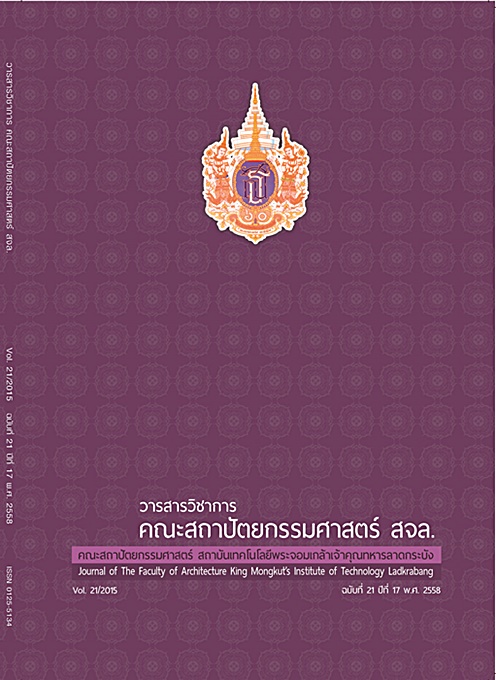แผ่นดินเบาและใยมะพร้าว เพื่อดูดความชื้นสำหรับห้องปรับอากาศ (Natural Clay and Coconut Fiber Board for Humidity Absorbtion in Air-Conditioned Room)
Main Article Content
บทคัดย่อ
บทคัดย่อ
งานวิจัยนี้ได้เสนอผลการออกแบบ และทดลองผนังจากวัสดุธรรมชาติที่มีความสามารถดูดความชื้น เพื่อนำมาใช้ลดความชื้นภายในอาคารที่ติดตั้งเครื่องปรับอากาศ โดยการนำดินเบาและใยมะพร้าวที่ศักยภาพในการดูดซับความชื้นภายในอาคารในสภาวะที่มีการควบคุมอุณหภูมิคงที่ การทดลองได้แบ่งออกเป็น 2 ขั้นตอน คือ ขั้นตอนที่ 1 ทดสอบแผ่นผนังจากดินเบาและใยมะพร้าว 3 แผ่นตัวอย่าง เพื่อหาแผ่นที่มีประสิทธิภาพที่ดีที่สุดในการดูดความชื้น ในกล่องทดลอง ขั้นตอนที่ 2 นำแผ่นตัวอย่างที่มีประสิทธิภาพที่ดีที่สุดมาทดลองในห้องทดลองที่มีการติดตั้งเครื่องปรับ อากาศ ซึ่งจากการนำผลการทดลองมาวิเคราะห์ความสามารถการดูดความชื้นพบว่า แผ่นตัวอย่างที่มีส่วนผสมของดินเบา 2 กิโลกรัมและใยมะพร้าว 0.5 กิโลกรัม มีประสิทธิภาพสูงสุดของการดูดซับความชื้นในระยะเวลา 4 ชั่วโมงแรกสามารถควบคุมความชื้นสัมพัทธ์ที่ 65% และเมื่อนำไปทดลองในห้องทดลองขนาด 16 ตารางเมตร พบว่า จำนวนพื้นที่ของแผ่นดินเบาและใยมะพร้าว 3.24 ตารางเมตรต่อพื้นที่ผิวภายในห้องทดลอง 48 ตารางเมตร ที่เปิดเครื่องปรับอากาศ ช่วงที่มีความชื้นภายนอกห้องทดลองสูงสุดที่ 91% ภายในห้องทดลองที่ติดตั้งแผ่นดินเบาและใยมะพร้าวสามารถควบคุมความชื้นอย่ที่ 52.8% ในขณะที่ห้องทดลองที่ไม่มีการติดตั้งแผ่นดินเบาและใยมะพร้าวมีความชื้นอยู่ที่ 60.5% ในช่วงเวลาตั้งแต่เวลา 03:00-05:00 น. แผ่นดินเบาและใยมะพร้าวจะมีประสิทธิภาพสูงสุด ซึ่งเป็นช่วงเวลาที่ความชื้นภายนอกอาคารสูงสุด และแผ่นดินเบาและใยมะพร้าวรักษาระดับความชื้นให้คงที่ได้ตลอดทั้ง
กลางวันและกลางคืนดีกว่าห้องทดลองที่ไม่มีการติดตั้งแผ่นผนังชนิดนี้
คำสำคัญ : ความชื้น ดินเบา ใยมะพร้าว ห้องปรับอากาศ
Abstract
The study presents the results of design and experiment of using natural clay and coconut fiber as humidity-absorbing board for air-conditioned rooms under temperature controlled conditions. The experiment was divided into two stages, namely, Stage 1 involving the testing of three sample boards made of clay and coconut fiber in order to determine which board has the highest efficiency in absorbing humidity, and Stage 2 where the sample board with the best efficiency was tested in an air-conditioned laboratory. Results show
that the sample board composed of 2 kilograms of natural clay and 0.5 kilograms of coconut fiber gave the highest rate of efficient humidity absorption during the first four hours and was able to control humidity under 65%. Furthermore, when the board was tested in a 16-square-meter laboratory, the area of the natural fiber board was 3.24-square-meter per 48-square-meter surface area in the air-conditioned room. While the maximum humidity outside the laboratory was 91%, the humidity inside the air-conditioned laboratory with the natural clay and coconut fiber humidity-absorbing board was 52.8% and the humidity in laboratory with no natural clay and coconut fiber humidity-absorbing board was 60.5% during the period from 3:00-5:00 am. The natural clay and coconut fiber humidity-absorbing board was most efficient during this time, which was when the humidity outside the room was highest. The room with natural clay and coconut fiber humidity-absorbing board installed was able to maintain humidity at all time, both day and night, better than the room without this type of board installed.
Keywords : Humidity Natural Clay Coconut Fiber Air-Conditioned Room
Article Details
This work is licensed under a Creative Commons Attribution-NonCommercial-ShareAlike 4.0 International License.
Copyright Transfer Statement
The copyright of this article is transferred to Journal of The Faculty of Architecture King Mongkut's Institute of Technology Ladkrabang with effect if and when the article is accepted for publication. The copyright transfer covers the exclusive right to reproduce and distribute the article, including reprints, translations, photographic reproductions, electronic form (offline, online) or any other reproductions of similar nature.
The author warrants that this contribution is original and that he/she has full power to make this grant. The author signs for and accepts responsibility for releasing this material on behalf of any and all co-authors.


